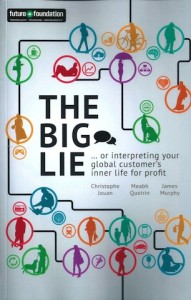The one-sentence summary
There is a gap between what people say in surveys and what they really think, so you need to work out what their answers actually mean.
WHAT THE BOOK SAYS 
· The Big Lie is the gap between social norms and private reality, between expressed opinions and inner emotions, between what people say in surveys and what their answer actually means.
· There is a juxtaposition between how people live inside their heads and the generalised assumptions made by those people and the companies that market to them.
· Businesses need to create products and communications campaigns that tap into consumers’ realities as well as their projected personas.
· Consumers need to feel good on two levels – a duality that needs recognising. This duplexity means consumers are capable of ‘living in two apartments at the same time.’
· Four main areas are dealt with:
1. Ever smarter consumers, endlessly irrational choices
Behavioural economics has exposed flawed decision making despite people having more information.
2. Power of Me, Value of We
Despite what individuals claim, groupthink and social copying dictate many decisions and opinions.
3. Comfortable Lives, Uncomfortable Truths
People will only go so far to live a truly co-friendly and green life.
4. The Call of Yesterday, The Scream of the New
Everyone claims things were better in the past, whilst craving everything that’s new.
WHAT’S GOOD ABOUT IT
· People now have effective knowledge – a good understanding of how everything works and how they should be seen to be behaving, so they can easily claim one thing and do another.
· They also have a new ruthlessness, and do not want to let go of their living standards.
· For consumers, perfect is often not worth the price.
· Research is pretty much incapable of replicating the living process that affects most purchasing decisions. No matter what people say in surveys, it’s never that simple.
· The Big Lie can = The Big Lazy. People may think responsibly, but then fail to act accordingly, creating a disconnect between opinion and action.
· More caring, positive, virtuous responses are offered in face-to-face interviews as opposed to online. People want to seem good in person.
WHAT YOU HAVE TO WATCH
· The book would benefit from a decent index.
· It is produced by the trends and forecasting agency The Future Foundation, and often strays into becoming a brochure for the company.
· The first half of the book is written in an over flowery style. A more balanced approach would have provided some academic calmness.
